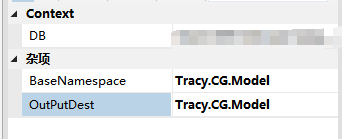1.首选需要一款生成工具:CodeSmith(从网上搜索下载即可)
2.然后提供两个模板文件代码如下:
一个文件起名:Untitled2.cst
<%@ Register Name="Model" Template="D:\Work\BLBL\DOC\Untitled1.cst" MergeProperties="False" ExcludeProperties="" %>
<%@ Template Language="C#" TargetLanguage="Text" %>
<%@ Property Name="BaseNamespace" Type="String" %>
<%@ Property Name="OutPutDest" Type="String" %>
<%@ Property Name="DB" Type="SchemaExplorer.DatabaseSchema" DeepLoad="True" Optional="False" Category="Context" Description="" %>
<%@ Assembly Name="SchemaExplorer" %>
<%@ Assembly Name="System.Design" %>
<%@ Import Namespace="SchemaExplorer" %>
<%
CodeTemplate codeTemplate=new Model();
codeTemplate.SetProperty("BaseNamespace",BaseNamespace);
codeTemplate.SetProperty("SourceDatabase",DB);
%>
<%foreach(TableSchema tb in DB.Tables){
codeTemplate.SetProperty("SourceTable",tb);
codeTemplate.RenderToFile(OutPutDest+@"\"+tb.Name+".cs",true);
}
%>另一个文件起名:Untitled1.cst
<%--
Name:OracleModel
Author:
Description: 根据指定的数据库生成业务逻辑类模板
--%>
<%@ CodeTemplate Language="C#" TargetLanguage="C#" Description="根据指定的数据库表生成访问层类模板" ResponseEncoding="Unicode" %>
<%@ Property Name="NameSpace" Type="System.String" Default="TRACY.CG.Model" Category="Context" Description="名称空间" %>
<%@ Property Name="DevelopersName" Type="String" Default="TRACY.CG.Model" Category="Context" Description="开发人员姓名" %>
<%@ Property Name="SourceTable" Type="SchemaExplorer.TableSchema" Category="Context" Description="数据库表名" %>
<%@ Assembly Name="SchemaExplorer" %>
<%@ Assembly Name="System.Data" %>
<%@ Import Namespace="SchemaExplorer" %>
<%@ Import Namespace="System.Data" %>
///
// <%= GetDecimal(SourceTable) %>
// ---------------------
// Copyright <%= DevelopersName%> <%= DateTime.Now.Year %> Our Client
// ---------------------
// History
// <%= DateTime.Now.ToShortDateString() %>
///
using System;
namespace <% =NameSpace %>
{
/// <summary>
/// <% =GetDecimal(SourceTable) %> <%=SourceTable.ExtendedProperties["CS"].Value %>
/// </summary>
[Serializable]
public class <% =GetDecimal(SourceTable) %>
{
public <% =GetDecimal(SourceTable) %>()
{}
#region Model
<% =GetVariables() %>
<% =GetMethod() %>
#endregion
}
}
<script runat="template">
// My methods here.
//截取字符串前面的小数点只显示后面的字符串
public string GetDecimal(TableSchema table)
{
return table.Name.Substring(table.Name.LastIndexOf(".")+1).ToString()+table.Description;
}
//判断数据类型是否为空
public string IsNull(ColumnSchema column)
{
if(column.AllowDBNull)
{
return "?";
}
return "";
}
//把字符串转换成小写
public string IsReplace(string str)
{
return str.ToLower();
}
#region 拼装字符串
#region 拼装初始值
public string GetVariables()
{
string str=string.Empty;
for(int i=0;i<this.SourceTable.Columns.Count;i++)
{
if(IsNull(this.SourceTable.Columns[i])=="")
{//数据类不型为空,数据类型不要加?
str+=string.Format("private {0} _{1};",
GetOracleDbType(this.SourceTable.Columns[i]),
IsReplace(this.SourceTable.Columns[i].Name));
}
else
{//为空时加问号
if(GetOracleDbType(this.SourceTable.Columns[i])=="string")
{//特殊情况数据类型是string类型不管为空,还是不能为空不能加?
str+=string.Format("private {0} _{1};",
GetOracleDbType(this.SourceTable.Columns[i]),
IsReplace(this.SourceTable.Columns[i].Name));
}
else
{//否则数据类型是非空类型后面带问号
str+=string.Format("private {0}? _{1};",
GetOracleDbType(this.SourceTable.Columns[i]),
IsReplace(this.SourceTable.Columns[i].Name));
}
}
if(i!=(this.SourceTable.Columns.Count-1))
{
str+="\r\n ";
}
}
return str;
}
#endregion
#region 拼装方法
public string GetMethod()
{
string str=string.Empty;
string a="{";
string b="}";
for(int i=0;i<this.SourceTable.Columns.Count;i++)
{
if(IsNull(this.SourceTable.Columns[i])=="")
{//数据类不型为空,数据类型不要加?
//拼装格式
str+="/// <summary>\r\n ";
str+="/// "+SourceTable.Columns[i].Description+" \r\n ";
str+="/// </summary>\r\n ";
str+=string.Format("public {0} {1}",
GetOracleDbType(this.SourceTable.Columns[i]),
this.SourceTable.Columns[i].Name);
str+="\r\n {\r\n ";
str+=string.Format("set{1} _{0} = value;{2}",IsReplace(this.SourceTable.Columns[i].Name),a,b);
str+="\r\n ";
str+=string.Format("get{1}return _{0};{2}",IsReplace(this.SourceTable.Columns[i].Name),a,b);
str+="\r\n }";
}
else
{//为空时加问号
if(GetOracleDbType(this.SourceTable.Columns[i])=="string")
{//特殊情况数据类型是string类型不管为空,还是不能为空不能加?
//拼装格式
str+="/// <summary>\r\n ";
str+="/// "+SourceTable.Columns[i].Description+" \r\n ";
str+="/// </summary>\r\n ";
str+=string.Format("public {0} {1}",
GetOracleDbType(this.SourceTable.Columns[i]),
this.SourceTable.Columns[i].Name);
str+="\r\n {\r\n ";
str+=string.Format("set{1} _{0} = value;{2}",IsReplace(this.SourceTable.Columns[i].Name),a,b);
str+="\r\n ";
str+=string.Format("get{1}return _{0};{2}",IsReplace(this.SourceTable.Columns[i].Name),a,b);
str+="\r\n }";
}
else
{//否则数据类型是非空类型后面带问号
//拼装格式
str+="/// <summary>\r\n ";
str+="/// "+SourceTable.Columns[i].Description+" \r\n ";
str+="/// </summary>\r\n ";
str+=string.Format("public {0}? {1}",
GetOracleDbType(this.SourceTable.Columns[i]),
this.SourceTable.Columns[i].Name);
str+="\r\n {\r\n ";
str+=string.Format("set{1} _{0} = value;{2}",IsReplace(this.SourceTable.Columns[i].Name),a,b);
str+="\r\n ";
str+=string.Format("get{1}return _{0};{2}",IsReplace(this.SourceTable.Columns[i].Name),a,b);
str+="\r\n }";
}
}
if(i!=(this.SourceTable.Columns.Count-1))
{
str+="\r\n ";
}
}
return str;
}
#endregion
#endregion
#region 判断数据类型
#region 根据列获取数据库的类型
///<summary>
///根据列获取数据库的类型
///<summary>
public string GetOracleDbType(ColumnSchema column)
{
switch (column.NativeType)
{
case "Char": case "char": case "CHAR":
case "varchar2": case "VarChar2": case "Varchar2": case "VARCHAR2":
case "nchar": case "Nchar": case "NCHAR":
case "nvarchar2": case "NVarChar2": case "NVARCHAR2":
case "Long": case "LONG": case "long":
case "Raw": case "RAW": case "raw":
case "Long raw": case "LONG RAW": case "long raw":
case "Rowid": case "rowid": case "ROWID":
case "Blob": case "blob": case "BLOB":
case "Clob": case "clob": case "CLOB":
case "nclob": case "NCLOB": case "Nclob":
case "Bfile": case "bfile": case "BFILE":
case "Urowid": case "urowid": case "UROWID":
return "string";
case "number": case "Number": case "NUMBER":
return "int";
case "double": case "Double": case "DOUBLE":
case "float": case "Float": case "FLOAT":
return "decimal";
case "DateTime": case "datetime": case "DATETIME":
case "Date": case "date": case "DATE":
return "DateTime";
default: return "__UNKNOWN__" + column.NativeType;
}
}
#endregion
#endregion
</script>然后使用工具CodeSmith打开这两个文件,
其中Untitled2.cst文件的第一行代码的 Template="D:\Work\BLBL\DOC\Untitled1.cst" 路径改为自己文件的路径下。
<%@ Register Name="Model" Template="D:\Work\BLBL\DOC\Untitled1.cst" MergeProperties="False" ExcludeProperties="" %>
然后注意Untitled1.cst文件里下面这两行的命名空间
Default="TRACY.CG.Model"
也改成自己想要的。
<%@ Property Name="NameSpace" Type="System.String" Default="TRACY.CG.Model" Category="Context" Description="名称空间" %>
<%@ Property Name="DevelopersName" Type="String" Default="TRACY.CG.Model" Category="Context" Description="开发人员姓名" %>然后配置工具里的数据库连接字符串:
比如:data source=192.1.0.100:1521/orcl;persist security info=True;user id=abc;password=123456
选择好连接后,Test测试一下链接,成功后选择这个链接。

填写命名空间和输出目录:

然后在Untitled2.cst上面的Tools菜单下点击Generate生成

成功后目录里多出一个目录:

目录里就是数据库里的所有表模型文件了:


OK.搞定。。。。
























 1489
1489











 被折叠的 条评论
为什么被折叠?
被折叠的 条评论
为什么被折叠?








